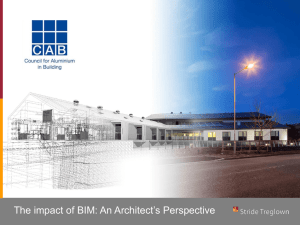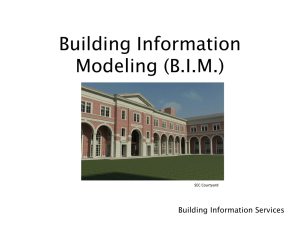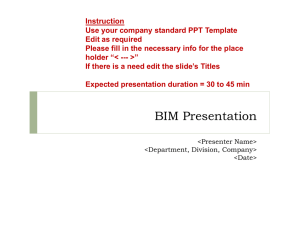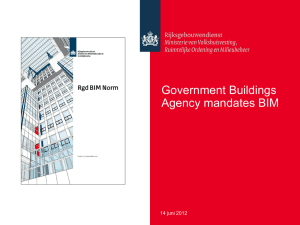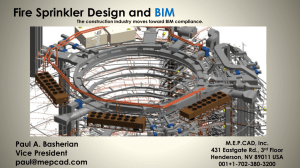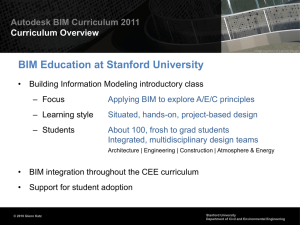20111209 IV.b BIM Powerpoint
advertisement
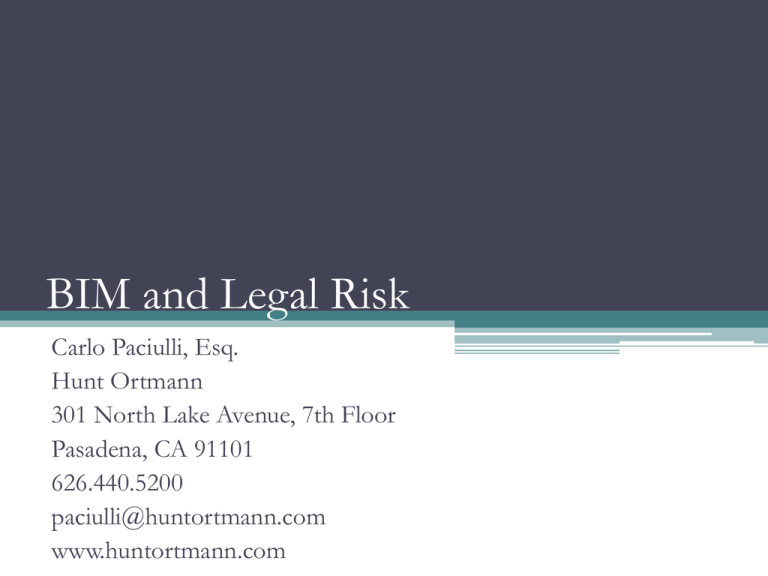
BIM and Legal Risk Carlo Paciulli, Esq. Hunt Ortmann 301 North Lake Avenue, 7th Floor Pasadena, CA 91101 626.440.5200 paciulli@huntortmann.com www.huntortmann.com Who Am I? • • • • • • Graduate architect Construction manager Project manager Contracting Officer’s Representative Licensed general contractor Construction law attorney Traditional Design Risk Traditional Design Risk • Traditional design-bid-build delivery • The “Spearin Doctrine” United States v. Spearin, 248 U.S. 132 (1918) • a 1918 decision holding there is an “implied warranty” in documents furnished by the owner • if the documents are complied with, “the work would be adequate” The Spearin Doctrine “…if [a] contractor is bound to build according to plans and specifications prepared by the owner, the contractor will not be responsible for the consequences of defects in the plans and specifications. This responsibility of the owner is not overcome by the usual clauses requiring builders to visit the site, to check the plans, and to inform themselves of the requirements of the work ….” What Did Spearin Allow? • Contractors could assert an action against the owner for breach of the implied warranty • The Court’s ruling shifted away from the contractor the responsibility for inadequate construction where the contractor was misled “by erroneous statements in the specifications” Gold Isn’t Pure … No One’s Perfect • No requirement that plans and specifications “be paragons of perfection” • Must be “reasonably accurate” • Defective documents are those that are “so faulty as to prevent or unreasonably delay completion of the contract performance” When is There a Spearin Breach? • Documents must be “substantially deficient or unworkable” • If there are many errors or omissions, the contract is breached if “the cumulative effect or extent of these errors was either unreasonable or abnormal” taking into account the scope and complexity of the project • Contractor must accurately follow and rely upon the defective plans and specifications Traditional Design Risk • Risk begins shifting where contractor participates in drafting specifications, participating in constructability reviews, etc. • The lines of division and responsibility become blurred Facts Matter • Key Factors: Does contractor have “superior knowledge” ▫ knowledge that is vital to performing a contract, but which is unknown and not reasonably available to bidders, who are thereby misled ▫ Contractor may gain such knowledge if it participates in design Facts Matter • Did contractor have “significant participation” in developing specification? • Did a “constructability” change alter design? • These factors are important because: the party that drafts, or changes, specifications is responsible for losses suffered by the other due to defects Facts Matter • Performance versus design specifications ▫ Design Specs = detailed map, warranty sets out in precise detail the materials and manner in which the work is to be performed contractor cannot deviate; required to follow “as one would a road map.” ▫ Performance Specs = achieved standard, no warranty sets objective or standard to be achieved contractor uses ingenuity to achieve standard, selects means, assumes responsibility Traditional Design and Risk • Does owner or contractor have “control” of the design? • With BIM, these risks may be harder to assess. What BIM Does Not Change? What BIM Does Not Change? • Design still provided by licensed design professionals • Contractor is still responsible for “Big Three” ▫ constructability ▫ means and methods ▫ shop drawings What BIM Does Not Change? • Growing concern in the industry about shifting legal risks • Properly implemented, BIM doesn’t shift risks ▫ ▫ ▫ ▫ Collaborative effort Transparent processes and open-information sharing May result in shared and decreased risk But contracts must define roles, responsibilities, risks BIM Creates Legal Issues BIM Creates Legal Issues • Contractors implementing BIM will suggest changes to model ▫ BIM tools increase likelihood of this scenario ▫ Clash detection will require design modification • Designers may feel less in control of design • Owners may wonder about performance of designer and software Legal Issues • No reported court decisions regarding BIM ▫ no legal guidelines or principles • Litigation and court cases may help ▫ “law” includes statutes and court decisions ▫ court decisions help interpret statutes and their application to facts ▫ this will take years A Cautionary Tale • Lawsuit involving life-sciences building at major university is the first known claim involving BIM • Architect and MEP engineers used BIM to fit the MEP systems into ceiling plenum • The tight fit depended on specific installation sequence; never communicated to contractor • 70% through assembly, no more room in plenum • Insurer’s settlement totaled “millions of dollars” • “If you don’t use BIM correctly, you can get into trouble” Legal Issues • Who owns the BIM model? Who manages it? ▫ Architect? Owner? Team? ▫ Should management responsibility shift? ▫ Who coordinates? • Who owns the copyright to the information and documents within the model? ▫ Each author? What about changes by others? • Who can change the model? Who has access? ▫ Too restrictive, less BIM and more CAD Legal Issues • Who takes risk related to changes in the model? ▫ Who bears risk of transmitting incorrect information? ▫ If originator is unknown, how is that risk assigned? • Who tracks the changes? • Is there a snapshot of the model at each iteration? ▫ Large project produces potentially thousands of changes and terabytes of data ▫ Enormous litigation cost might exceed value of claims Legal Issues • Insurance ▫ Carriers only beginning to come to grips with BIM; no or limited BIM claims history ▫ Does A/E liability insurance adequately cover potential BIM exposures? ▫ Is legal industry behind the curve? • Third party disputes ▫ If pedestrian is hurt, if building collapses, answer may lie within BIM model ▫ Proof may be difficult for plaintiff and defense • Software maker ▫ What about defective algorithm? Is remedy limited to cost of software? Should it be? Risk Risk • Maximizing BIM involves giving each party access to model • Many or all may modify model • What are the risks? ▫ ▫ ▫ ▫ ▫ Development, control, use of model Design errors and omissions Cost estimating and control Facilities management and operations Preserving the model Risk: Development and Control • Once architect develops model, subsequent changes create exposures • Multiple parties making changes raises intellectual property issues for each user • What if model is used and altered for other project? • Where is model stored? ▫ One network? Multiple networks? ▫ Private project website? ▫ Drawings go in file drawer Risk: Errors and Omissions • Many jurisdictions allow contractors to sue architects for poor drawings ▫ Negligent misrepresentation • BIM demands closer relationships ▫ All parties not in privity of contract ▫ Negligence claims might increase on design standard of care Risk: Cost Estimating and Control • BIM allows early collaboration ▫ Allows early cost estimating ▫ Allows early design modifications for cost control ▫ Make design comply with budget • BIM might solidify owner cost/budget expectation • Increased estimating accuracy doesn’t guard against price fluctuations, bidding strategies, “race to the bottom” Risk: Facilities Management • Increased BIM usage parallels shift to energy-efficient design • Energy efficiency can be measured against design assumptions • Reviewing designed efficiency against actual performance critical in determining liability Risk: Preserving the Model • Final design isn’t saved to file drawer • All changes have to be captured, backed up • Before completion, what happens if: ▫ ▫ ▫ ▫ Network crashes Data becomes corrupted Significant delay to recreate model Data preservation fails. Who’s responsible? Risk Allocation • Probably most important issue • Two Approaches ▫ Rely on case law interpreting traditional design risk ▫ Include specific BIM risk allocation in contracts Risk Allocation • Case Law ▫ There isn’t any ▫ Might become a contest over traditional Spearin Doctrine of implied warranty ▫ Results are unpredictable Risk Allocation • Contract Approach ▫ ▫ ▫ ▫ ConsensusDOCS 301 BIM Addendum AIA IPD with BIM Protocol Exhibit Draft BIM Rider Defines and establishes Parties and definitions BIM Scope of Work Risk Allocation Ownership Rights Damages Risk Allocation on Damages • General concepts ▫ ▫ ▫ ▫ Each responsible for direct damages they cause Avoid “intangible”(consequential) damages Limiting range of damages might reduce incentive to sue Address these issues in contracts Risk Allocation on Damages • Each responsible for direct damages ▫ Contributor can be sued for direct damages caused by relying on the contributions to the model • Each waives right to seek consequential damages ▫ ▫ ▫ ▫ ▫ ▫ Lost profits Lost income Loss of use of the project Lost business Overhead expenses Insolvency 36 Q&A Carlo Paciulli Hunt Ortmann Palffy Nieves Lubka Darling & Mah, Inc. Pasadena, California September 28, 2011

